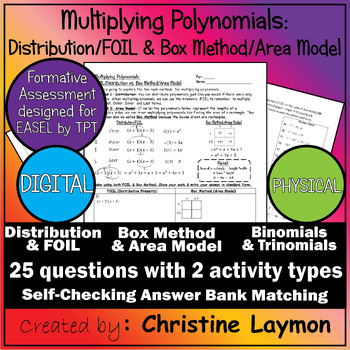Multiplying Polynomials | Distribution FOIL Box Method Area Model
- PDF
- Internet Activities
- Easel Activity
- Easel Assessment
Description
- Activity 1: 10 method comparing questions
- Students multiply polynomials using BOTH Distributive Property (or FOIL) AND Box Method (Area Model).
- Contains notes on how to multiply polynomials
- Activity 2: 15 self-checking matching questions with an Answer Bank.
- Students have to multiply out each polynomial using EITHER Distribution/FOIL OR Box Method (Area Model).
- 1 Activating Prior Knowledge Warm Up
- Student multiply integers, decimals, and mixed numbers using an Area Model
- Students will multiply:
- binomial * binomial
- binomial * trinomial
Contents:
- 3 Student Activity Pages (non-editable PDFs) (includes notes on first page). (enabled for EASEL by TPT as of 7/13/22)
- 1 Teacher Details/Contents Page
- 1 Teacher Talk Ideas page
- 1 Suggested Use page
- 1 “Activating Prior Knowledge” Warm Up
- 1 Answer Key (4 pages) + Teacher Notes
- BONUS: 1 Formative Assessment specifically designed for EASEL by TPT!
- Multiple Choice (10 questions - 1 per slide)
- 6 find/fix the mistake questions
- 4 multiply the polynomial questions
- Multiple Choice (10 questions - 1 per slide)
- 4 Likert Scale Polls for student feedback (4 Questions - 1 per slide)
NOTES: While this factoring deals with multiplying and not factoring, this can be a useful activity to bridge the related concepts.
TIME:
The amount of time needed depends on the skills and focus of your class. While it is possible that some students are done in 1 class period, I have found that the vast majority of my students need 2 periods (or 1 period + HW) to complete the assignment.
Related Products:
- Check out "Special Polynomial Patterns | Products and Factors | Fill In the Blank"
- If you have a need for more basic polynomial activities, check out "Polynomials | Classification Standard Form Degree Leading Coeffiicent"
- Check out "Descartes's Rule of Signs Practice" for an Alg 2 level activity.
- Are your students learning radicals? Check out "Square and Cube Root Transformation Quiz EDITABLE (Digital + Physical)"
- For a fun Exponent review, check out "Exponent Properties Self Checking Cross Out Review"
- Are your students learning Absolute Value with the distance definition? Check out "Writing Absolute Value Inequalities Distance Definition BUNDLE"
- Looking for more Alg 1 or Alg 2 resources? Check out what I have to offer!
---------------------------------------------------------------------
⭐ Earn TPT Credits! ⭐
- After you have used the resource (at least 24 hours after purchase), earn TPT Credits by going to My Purchases and then leaving Feedback/Reviews on the resource! More info can be found in TPT's FAQ here.
- Feedback on free resources is appreciated too but will not earn you credits.
Connect with me!
Questions? You can use the TPT Q&A feature for this product or email me at ChristineLaymon123@gmail.com
©2022-2024 Christine Laymon
Please note - this resource is for use by the purchasing teacher only.
Electronic distribution is limited to the purchaser's classes only. Please use this resource in the spirit that it is intended.






